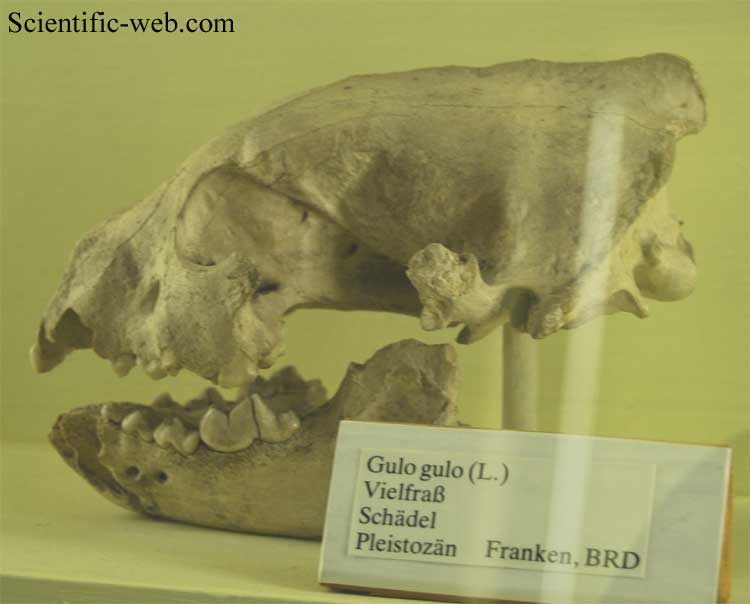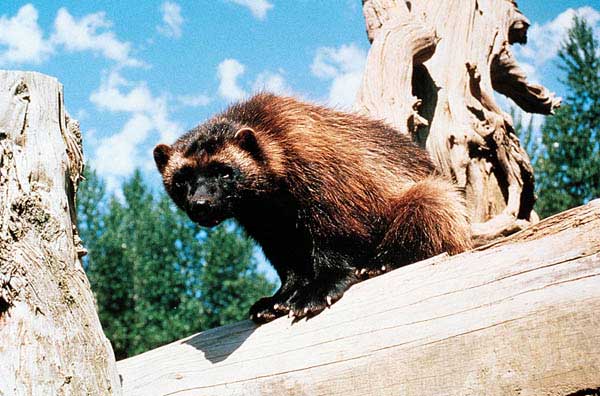Gulo gulo, Photo: Michael Lahanas Cladus: Eukaryota Name Gulo gulo (Linnaeus, 1758) Type Locality: "alpibus Lapponiæ, Ruffiae, Sibiriae, sylvis vastissimis", restricted by Thomas (1911a) to "Lapland". References * Linnaeus, C. 1758. Systema Naturae per regna tria naturae, secundum classis, ordines, genera, species cum characteribus, differentiis, synonymis, locis. Tenth (10 th) Edition, Laurentii Salvii, Stockholm, 1:45
Gulo gulo, United States Department of Transportation Vernacular names ---------- The wolverine (Gulo gulo), also referred to as glutton, carcajou, skunk bear, quickhatch, or gulon, is the largest land-dwelling species of the Mustelidae (weasel) family in the genus Gulo (Latin: "glutton"). It is a stocky and muscular carnivore, more closely resembling a small bear than other mustelids. The wolverine has a reputation for ferocity and strength out of proportion to its size, with the documented ability to kill prey many times its size. The wolverine is distributed primarily in remote reaches of the Northern boreal forests and subarctic and alpine tundra of the Northern hemisphere, with the greatest numbers in Alaska, Canada, the Nordic countries of Europe and throughout western Russia and Siberia. Their populations have experienced a steady decline since the 19th century in the face of trapping, range reduction and habitat fragmentation, such that they are essentially absent in the southern end of their European range. It is however estimated that large populations remain in North America and North Asia.[2] Taxonomy Genetic evidence suggests that the wolverine is most closely related to the tayra and martens (Eira, and Martes respectively), all of which shared a Eurasian ancestor.[3] Within the Gulo genus, there is a clear separation between two subspecies: the Old World form Gulo gulo gulo and the New World form G. g. luscus. Some authors had described as many as four additional North American subspecies, including ones limited to Vancouver Island (G. g. vancouverensis) and the Kenai Peninsula in Alaska (G. g. katschemakensis). However, the most currently accepted taxonomy recognizes either the two continental subspecies or recognize G. gulo as a single Holarctic taxon.[4] Recently compiled genetic evidence suggests that most of North America's wolverines are descended from a single source, likely originating from Beringia during the last glaciation and rapidly expanding thereafter, though there is considerable uncertainty to this conclusion due to the difficulty of collecting samples in the extremely depleted southern extent of the range.[4] Physical characteristics Anatomically, the wolverine is a stocky and muscular animal. With short legs, broad and rounded head, and small eyes with short rounded ears, it resembles a bear more than other mustelids. Its legs are short, while its large five-toed paws and plantigrade posture facilitate movement through deep snow.[5] The adult wolverine is about the size of a medium dog, with a length usually ranging from 65 – 87 cm (25 – 34 inches), a tail of 17 – 26 cm (7 – 10 inches), and a weight of 10–25 kg (22 – 55 lb), though exceptionally large males can weigh over 31 kg (70 lb).[6] The males are as much as 30 percent larger than the females. It is the largest of terrestrial mustelids; only the marine dwelling sea otter and giant otter are larger. Wolverines have thick, dark, oily fur which is highly hydrophobic, making it resistant to frost. This has led to its traditional popularity among hunters and trappers as a lining in jackets and parkas in Arctic conditions. A light silvery facial mask is distinct in some individuals, and a pale buff stripe runs laterally from the shoulders along the side and crossing the rump just above a 25–35 cm bushy tail. Some individuals display prominent white hair patches on the throat or chest.[5] Like many other mustelids, it has potent anal scent glands used for marking territory and sexual signalling. The pungent odor has given rise to the nicknames "skunk bear" and "nasty cat." Wolverines, like other mustelids, possess a special upper molar in the back of the mouth that is rotated 90 degrees, towards the inside of the mouth. This special characteristic allows wolverines to tear off meat from prey or carrion that has been frozen solid.[7][8] Behavior The wolverine is, like most mustelids, remarkably strong for its size. It has been known to kill prey as large as moose, although most typically when these are weakened by winter starvation or caught in deep snow. Wolverines inhabiting the Old World (specifically, Fennoscandia) are more active hunters than their North American cousins.[9] This may be because competing predator populations in Eurasia are not as dense, making it more practical for the wolverine to hunt for itself than to wait for another animal to make a kill and then try to snatch it. They often feed on carrion left by wolves, so that changes in the population of wolves may affect the population of wolverines.[10] Wolverines are also known on occasion to eat plant material.[11] Armed with powerful jaws, sharp claws, and a thick hide,[12] wolverines may defend kills against larger or more numerous predators.[13] There is at least one published account of a 27-pound wolverine's attempt to steal a kill from a black bear (adult males weigh 400 to 500 pounds). Unfortunately for the mustelid, the bear won what was ultimately a fatal contest.[14] Wolverines have been known to harass and attempt to intimidate wolves and cougars. Mating season is in the summer, but the actual implantation of the embryo (blastocyst) in the uterus is stayed until early winter, delaying the development of the fetus. Females will often not produce young if food is scarce. The wolverine gestation period is 30–50 days. Litters of typically two or three young ("kits") are born in the spring. Kits develop rapidly, reaching adult size within the first year of a lifespan that may reach anywhere from five to (in exceptional individuals) thirteen years. Adult wolverines have no natural predators, though they do come into conflict with (and may be killed by) other large predators over territory and food. Juveniles are more vulnerable; infants (kits) have been known on occasion to be taken by predatory birds such as eagles.[15] Range The Wildlife Conservation Society reported in June 2009 that a wolverine researchers had been tracking for almost three months had crossed into northern Colorado. Society officials had tagged the young male wolverine in Wyoming near Grand Teton National Park and it had traveled southward for approximately 500 miles. It was the first wolverine seen in Colorado since 1919, and its appearance was also confirmed by the Colorado Division of Wildlife.[11] The world's total wolverine population is unknown. The animal exhibits a low population density and requires a very large home range.[10] The range of a male wolverine can be more than 620 km² (240 sq mi), encompassing the ranges of several females which have smaller home ranges of roughly 130–260 km² (50-100 sq mi). Adult wolverines try for the most part to keep non-overlapping ranges with adults of the same sex.[8] Radio tracking suggests an animal can range hundreds of miles in a few months. This requirement for large territories brings wolverines into conflict with human development, and hunting and trapping further reduce their numbers, causing them to disappear from large parts of their former range; attempts to have them declared an endangered species have met with little success.[10] Name The wolverine's questionable reputation as an insatiable glutton (reflected in the Latin genus name Gulo) may be in part due to a false etymology. The animal's name in old Swedish, fjellfräs, meaning "mountain cat," worked its way into German as Vielfraß, which means roughly "devours much." Its name in other West Germanic languages is similar (e.g. Dutch veelvraat). The Finnish name is ahma, derived from ahmatti, which is translated as "glutton". Similarly, the Estonian name is ahm, with the equivalent meaning to the Finnish name. The Russian росомаха (rosomakha) and the Polish and Czech name rosomak, seem to be borrowed from the Finnish rasva-maha (fat belly). Similarly, the Hungarian name is rozsomák or torkosborz which means gluttonous badger. In French speaking parts of Canada, the wolverine is referred to as carcajou, borrowed from the Innu-aimun or Montagnais kuàkuàtsheu.[22] Purported gluttony is reflected neither in English nor in North Germanic languages. The English word wolverine (alteration of the earlier form wolvering of uncertain origin) probably implies 'a little wolf'. The name in Old Norse, jarfr, lives on in the regular Icelandic name jarfi, regular Norwegian name jerv, regular Swedish name järv and regular Danish name jærv. The modern Swedish word djärv is pronounced in the same way, and is directly translated to brave or courageous. As a symbol Many cities, teams, and organizations use the wolverine as a mascot. For example, the U.S. state of Michigan is, by tradition, known as "The Wolverine State," and the University of Michigan takes the wolverine as its mascot. The association is well and long established: for example, many Detroiters volunteered to fight during the American Civil War and George Armstrong Custer, who led the Michigan Brigade, called them the "Wolverines." The origins of this association are obscure; it may derive from a busy trade in wolverine furs in Sault Ste. Marie in the 18th century or may recall a disparagement intended to compare early settlers in Michigan with the vicious mammal. Wolverines are, however, extremely rare in Michigan. A sighting in February 2004 near Ubly was the first confirmed sighting in Michigan in 200 years.[23] The animal was found dead in 2010. [24] The wolverine figures prominently in the mythology of the Innu people of eastern Québec and Labrador. In at least one Innu myth, it is the creator of the world.[25] In captivity * Detroit Zoo - On May 19, 2005, the Detroit Zoo announced the birth of two Wolverine kits (Gulo gulo). At the time, there were only 77 wolverines in captivity worldwide.[26]
The 91 minute motion picture, Running Free (as known as One Paw) is about a young boy and his friendship with an Alaskan wolverine. The wolverines seen in the film were born in captivity and directed by U.S.D.A. licensed filmmaker, Steve Kroschel. Many of the wolverine scenes are documentary footage of trained wolverines that are being filmed in their natural habitat. The movie was screened in October 5, 1994. The American Humane Society was involved before the start of filming and during some of the filming.[33] References 1. ^ Wozencraft, W. C. (16 November 2005). "Order Carnivora". in Wilson, D. E., and Reeder, D. M. eds. Mammal Species of the World (3rd ed.). Baltimore: Johns Hopkins University Press. pp. 532–628. ISBN 0-801-88221-4. http://www.bucknell.edu/msw3/browse.asp?id=14001166.
Source: Wikispecies, Wikipedia: All text is available under the terms of the GNU Free Documentation License |
|



